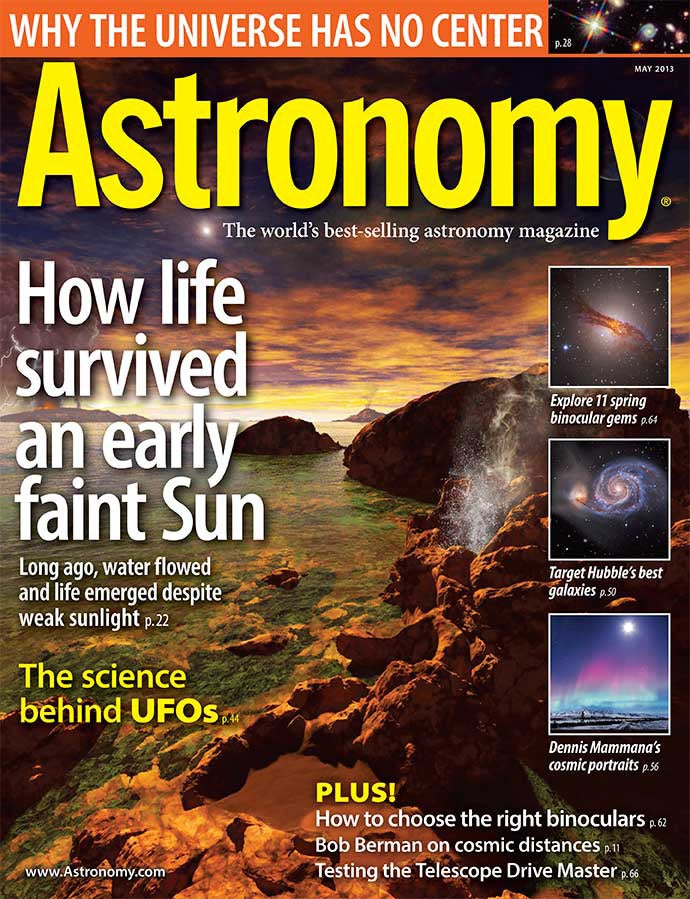
WAUKESHA, Wis. — When Earth became a solid planet more than 3.5 billion years ago, the Sun was only 70 percent as bright as it is today. For the first billion of those years, its water should have been frozen. Geologic evidence from that epoch, however, shows that liquid water existed and life thrived on a planet more than 100° warmer than models of the early solar system say it would have been.
In “How life survived a cool early Sun,” Bruce Dorminey explores this discrepancy, which is known as the “faint young Sun paradox.” The problem is far from settled, though, and Dorminey and expert scientists discuss the various explanations for Earth’s ability to harness the Sun’s faint power and use it to warm the primordial soup from which primitive life emerged.
To learn about how life thrived around our formerly dim star, pick up the May issue of Astronomy, on newsstands April 5.
“The science behind UFOs”
Witnesses report thousands of unidentified flying objects (UFOs) each year. While they range from reappearing lights to objects that appear to be hovering, their explanations, as “Bad Astronomer” Philip Plait explains in this article, are scientific and technological. The article examines several famous UFO sightings and explains how being knowledgeable about astronomy and being aware of the sky can help you identify even the strangest of sights. Use Plait’s guide to distinguish between the heavens, hoaxes, and hot air.
“Why the universe has no center”
The beginning of the universe was a strange time, set off initially by the Big Bang. But what, exactly, was the Big Bang? And what came before it? Associate Editor Liz Kruesi interviewed six cosmology experts to sort out the universe’s start, the unseeable period just afterward, its current size, and its ever-expansion. At the heart of the questions and the cosmologists’ answers is an investigation into the limits the universe itself puts on observational astronomy.
“Target Hubble’s galaxy classes”
Alan Goldstein describes Edwin Hubble’s galaxy classification system and the characteristics that allow astronomers both amateur and professional to distinguish between them. Then, he provides a list of exemplary galaxies in each category, how best to observe them, and what you can expect to see when you do.
May sky events visible without optical aid
- May 2 — Last Quarter Moon occurs at 7:14 a.m. EDT
- May 9 — New Moon occurs at 8:28 p.m. EDT; annular solar eclipse
- May 18 — Venus passes 6° north of Aldebaran
- May 23 — The Moon passes 4° south of Saturn
Also in the May 2013 Astronomy
- “Dennis Mammana’s cosmic portraits” — This night sky photographer focuses on wide-field shots astronomical phenomena that can be seen without a telescope: Aurorae, the plane of the Milky Way, and the zodiacal light all make appearances.
- “How to choose the right binoculars” — Binoculars allow your eye to collect more light and resolve details. But have you ever wondered what all those numbers in their names and specs mean?
- “Explore 11 spring binocular gems” — Once you have the right binoculars, start using them to view the season’s best galaxies, star clusters, and double-star systems.
- “Astronomy tests the Telescope Drive Master” — Mike Reynolds tries this piece of equipment that smooths telescope drive by correcting periodic, systematic errors in the mount’s tracking.
- “The Sky this Month” — Exclusive star charts will guide you through May’s night sky.
- The May issue also includes Astro News, Ask Astro, Snapshot, Breakthrough, Bob Berman’s Strange Universe, Stephen James O’Meara’s Secret Sky, Glenn Chaple’s Observing Basics, Tony Hallas’ Cosmic Imaging, Cosmic World, Letters, Web Talk, New Products, Reader Gallery, and Final Frontier.









